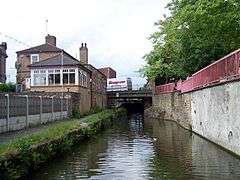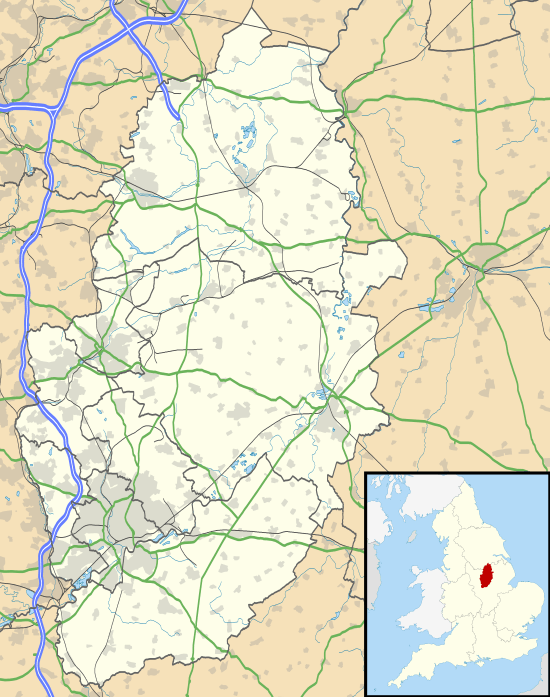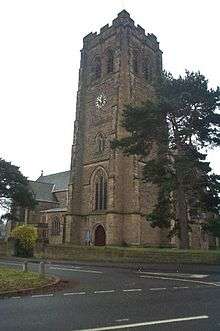Worksop
Worksop (/ˈwɜːrksɒp/ WURK-sop) is the largest town in the Bassetlaw district of Nottinghamshire, England. Worksop lies on the River Ryton, and is located at the northern edge of Sherwood Forest. Worksop is located 19 miles (31 km) east-south-east of Sheffield, with a population of 41,820.[2] It lies close to Nottinghamshire’s borders with South Yorkshire, and Derbyshire.
| Worksop | |
|---|---|
 Approaching Worksop Town Lock | |
 Worksop Location within Nottinghamshire | |
| Population | 41,820 [1] |
| Demonym | Worksopian |
| OS grid reference | SK 58338 78967 |
| District | |
| Shire county | |
| Region | |
| Country | England |
| Sovereign state | United Kingdom |
| Post town | WORKSOP |
| Postcode district | S80, S81 |
| Dialling code | 01909 |
| Police | Nottinghamshire |
| Fire | Nottinghamshire |
| Ambulance | East Midlands |
| UK Parliament | |
Worksop has become a commuter town as a result of its geographic location and ease of access to major motorways and rail links.
Worksop is known as the "Gateway to The Dukeries", because of the now four obsolete ducal principal sites of which were closely located next to each other, south of the town. These four ducal locations were; Clumber House, Thoresby Hall, Welbeck Abbey and Worksop Manor. Other houses such as Rufford Abbey and Hodsock Priory are also just a few miles away.
Worksop is twinned with the German town Garbsen.
History
Evidence that Worksop existed before the Norman conquest of England in 1066 is provided by the Domesday Book of 1086:
- "In Werchesope, (Worksop) Elsi (son of Caschin) had three carucates of land to be taxed. Land to eight ploughs. Roger has one plough in the demesne there, and twenty-two sokemen who hold twelve oxgangs of this land, and twenty-four villanes and eight bordars having twenty-two ploughs, and seven acres of meadow. Wood pasture two miles long, and three quarentens broad."[3]
In about 1103, William de Lovetot established a castle and the Augustinian priory at Worksop. Subsequently, Worksop grew into a market town.
A skirmish occurred in the area during the Wars of the Roses on 16 December 1460, commonly known as the Battle of Worksop.
The building of the Chesterfield Canal in 1777, and the subsequent construction of the Manchester, Sheffield and Lincolnshire Railway in 1849, both of which passed through the settlement, led to a degree of growth. Discovery of sizeable coal seams further increased interest in the area.
Coal mining provided thousands of jobs in and around Worksop for most of the 19th and 20th centuries.
Additionally, much of the area being heavily forested, timber was always an important industry - supplying railway sleepers to the North Midland Railway, timber for the construction of railway carriages and packing cases for the Sheffield cutlery industry. The town also became notable for the manufacture of Worksop Windsor Chairs. Timber firms in the town included Benjamin Garside’s woodyard and Godley and Goulding, situated between Eastgate and the railway.[4]
The closure in the 1990s of the pits, compounding the earlier decline of the timber trade and other local industry, resulted in high unemployment and the soaring of local drug abuse.[5]
Unemployment levels in the area are now lower than the national average, owing to large number of distribution and local manufacturing companies, including Premier Foods, Wilko, RDS Transport, Pandrol UK Ltd and Laing O'Rourke.
Transport
Rail
Worksop is on the Sheffield-Lincoln line, with direct trains running to Sheffield, Leeds and Lincoln. Services call at Retford, Gainsborough, Saxilby, Shireoaks, Kiveton Park, Kiveton Bridge, Woodhouse, Darnall, Meadowhall, Barnsley and Wakefield. These services are run by Northern. Worksop is also the terminus of the Robin Hood line to Nottingham via Mansfield, a service run by East Midlands Railway. On Saturdays Northern also runs three services to Grimsby and Cleethorpes via Gainsborough.
Education
Primary
- Gateford Park Primary School
- Haggonfields Primary and Nursery School
- Holy Family Catholic Primary School
- Norbridge Academy
- Kingston Park Academy
- Langold Dyscarr Community School
- Prospect Hill Infant and Nursery School
- Prospect Hill junior school
- Ramsden Primary School
- Redlands Primary And Nursery School
- Sparken Hill Academy
- Sir Edmund Hillary Primary School
- St. Augustine's School
- St Anne's C Of E Voluntary aided Primary School
- St John's C of E Academy
- St Luke's C of E Aided Primary School
- Worksop Priory C of E Primary Academy
- The Primary School of St Mary and St Martin
Further education
- North Nottinghamshire College
- Outwood Post-16 centre
Healthcare
Worksop is served by Bassetlaw District General Hospital, part of the Doncaster and Bassetlaw NHS Foundation Trust. Bassetlaw Hospital treats ~33,000 people each year, as well as ~38,000 emergencies. Bassetlaw Hospital is one of the University of Sheffield Teaching hospitals Medical School.
Mental Health services in Worksop are provided by Nottinghamshire Healthcare NHS Trust who provide both in-patient and community services. Wards run by Nottinghamshire Healthcare provide training for medical students at the University of Nottingham.
Local economy
The local economy in Worksop is dominated by service industries, manufacturing and distribution.
Major employers in the area include Premier Foods, Greencore, Wilko, RDS Transport (the Flying Fridge), B&Q, MAKE polymers,[6] OCG Cacao, part of Cargill, Pandrol, GCHQ and the NHS (Doncaster and Bassetlaw NHS Trust and Nottinghamshire Healthcare NHS Trust).
Religion

Worksop has three churches which are all on the National Heritage List for England.
Officially titled the Priory Church of Saint Mary and Saint Cuthbert, is the Anglican parish church usually known as Worksop Priory. It was an Augustinian Priory founded in 1103. The church has a nave and detached gatehouse. Monks at the priory made the Tickhill Psalter, an illuminated manuscripts of the medieval period, now held in New York Public Library. After the dissolution of the Monasteries the east end of the church fell into disrepair, but the townspeople were granted the nave as a parish church. The eastern parts of the building have been restored in several phases, the most recent being in the 1970s when the architect Lawrence King rebuilt the crossing.
St. Anne's Church is an Anglican parish church and is recorded in the National Heritage List for England as a designated Grade II listed building.[7] The church was built in 1911 by the Lancaster architects Austin and Paley.[8][9] The church has an historic pipe organ originally built by Gray and Davison in 1852 for Clapham Congregational Church.
St. John's Church is a Parish church built between 1867 and 1868 by architect Robert Clarke.
Places of interest
Mr Straw's House, the family home of the Straw family, was inherited by the Straw brothers, William and Walter when their parents died in the 1930s. The house remained unaltered until the National Trust acquired it in the 1990s and opened it to the public.[10] Clumber Park, south of Worksop is a country park, also owned by the National Trust, and is open to the public.
Notable people
- James Walsham Baldock (1822–1898), artist[11]
- Maurice Bembridge, golfer
- Ian Bennett, footballer
- George Best, former goalkeeper with Blackpool
- Basil Boothroyd, humorous writer
- Bruce Dickinson, singer with Iron Maiden
- Craig Disley, footballer
- Mark Foster, golfer
- Anne Foy, former BBC Children's TV presenter
- Alexina Graham, model and Victoria's Secret Angel
- Gwen Grant, writer
- Henry Haslam, footballer and Olympic gold medalist at the 1900 Olympics
- Sarah-Jane Honeywell, BBC Children's TV presenter
- William Henry Johnson, recipient of a Victoria Cross
- Mick Jones, Sheffield United and Leeds United striker during the 1960s and 70s
- Jade Moore, footballer
- Liam Palmer, Sheffield Wednesday footballer
- John Parr, musician
- Henry Pickard, cricketer
- Donald Pleasence, actor
- Graham Taylor, former England manager
- Danny Thomas, footballer, played for Coventry City F.C. & Tottenham Hotspur
- Darren Ward, former football goalkeeper
- Lee Westwood, golfer (reached world number one in 2010, 2011)
- Elliott Whitehouse, footballer
- Mary (Barnard) Williams (1609–1676), wife of Roger Williams, founder of Rhode Island
- Chris Wood, footballer
References
Notes
- "WORKSOP in Nottinghamshire (East Midlands)".
- citypopulation.info
- White, Robert (1875) Worksop, The Dukery, and Sherwood Forest. Transcription at Nicholson, AP: Nottinghamshire History (Accessed 24 December 2005).
- Stroud, G. (2002) Nottinghamshire Extensive Urban Survey, Worksop. English Heritage
- Boniface, Susie (24 October 2010). "George Osborne wreaks havoc .. just like Margaret Thatcher in 1980s". The Mirror.
- "Site confirmed for MBA Polymers' UK plant". Recycling International. Archived from the original on 11 June 2016. Retrieved 12 April 2014.
- Historic England, "Church of St Anne, Worksop (1045754)", National Heritage List for England, retrieved 30 August 2012
- Pevsner 1979, p. 389.
- Brandwood et al. 2012, p. 248.
- Mr Straw's House Archived 8 May 2006 at the Wayback Machine by The National Trust, accessed 28 May 2006.
- "James Walsham Baldock". www.avictorian.com. Retrieved 14 January 2019.
Sources
- Brandwood, Geoff; Austin, Tim; Hughes, John; Price, James (2012), The Architecture of Sharpe, Paley and Austin, Swindon: English Heritage, ISBN 978-1-84802-049-8
- Pevsner, Nikolaus (1979), Nottinghamshire, Pevsner Architectural Guides: Buildings of England (2nd ed.), New Haven and London: Yale University Press, ISBN 978-0300096361
External links
| Wikimedia Commons has media related to Worksop. |
| Wikivoyage has a travel guide for Worksop. |